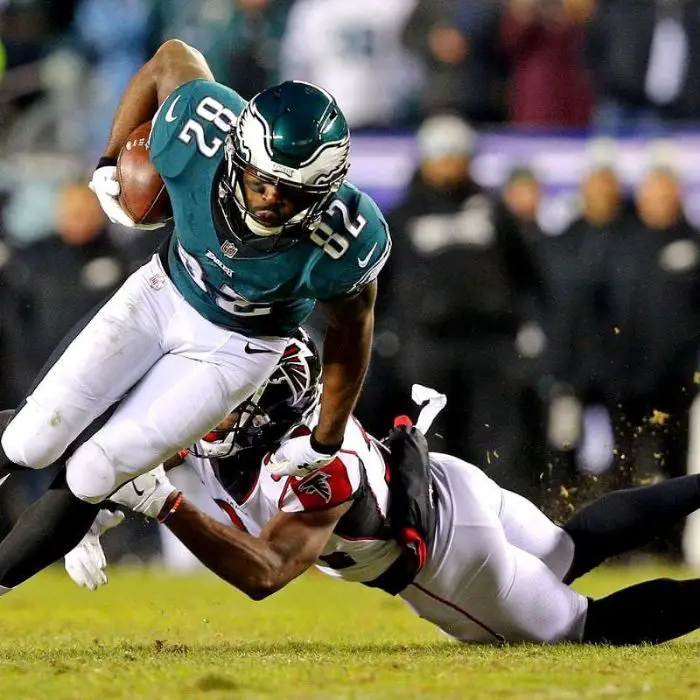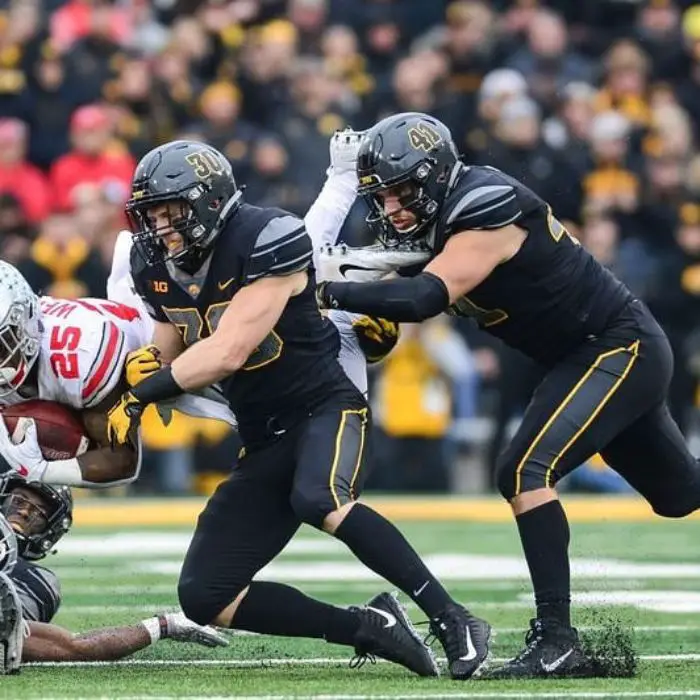Rugby and American football differ in gameplay and equipment. American football involves set moves like chess, while rugby is more free-flowing and spontaneous.
American football utilizes oblong-shaped balls and goalposts, while rugby employs standardized rounder balls and H-shaped posts. Both sports share physicality and aggression, but they have distinct rules and gameplay styles that attract different fan bases.
In America, Walter Camp’s innovations led to the divergence of American football from its rugby roots, and the introduction of the forward pass marked a significant turning point in this evolution.
These differences showcase the diversity of sports and the distinct appeal each holds for its followers, with both making unique contributions to the world of athletics.
Origin And Evolution

The history of rugby can be traced back to the 19th century in England, where the game evolved from a combination of football and soccer. American Football, on the other hand, was developed in the United States during the late 19th and early 20th centuries, borrowing elements from rugby and soccer.
Key milestones in rugby’s evolution include the standardization of rules and the establishment of international competitions, while American Football saw significant developments with the introduction of the forward pass and the emergence of the National Football League (NFL).
Both sports have unique characteristics and gameplay styles. Rugby is known for its free-flowing, spontaneous nature, while American Football involves set plays and strategic moves.
Additionally, the ball used in each sport differs in shape and size, with rugby balls having almost flat ends and American football featuring sharp ends. Despite their similarities in physicality and aggression, the two sports have distinct rules and regulations, making them genuinely unique experiences for players and fans alike.
Scoring Systems
When it comes to scoring systems, there are several key differences between rugby and American football. In rugby, a “try” is scored by grounding the ball in the opponent’s in-goal area, earning 5 points, whereas in American football, a touchdown is achieved by carrying or catching the ball across the opponent’s goal line, also worth 6 points.
Additionally, rugby uses a goal-kicking method to earn additional points after a try, while American football utilizes field goals for scoring. The goal-kicking in rugby involves kicking the ball through the uprights and earning 2 points, whereas field goals in American football are worth 3 points when successfully kicked through the uprights.
Game Duration And Structure
Match periods in rugby: Rugby matches consist of two halves, each lasting 40 minutes, with a 10-minute break in between.
Quarter system in American football: American football is divided into four quarters, each lasting 15 minutes, with a halftime break.
Time management differences: Rugby gameplay is continuous, with the clock being stopped for certain events, whereas American football has a more stop-start nature, with the clock being stopped after each play and during various game situations.
Player Positions And Roles

Rugby positions overview: In rugby, the players are typically divided into two main groups: forwards and backs. The forwards are the larger, more physical players who are involved in the scrums, lineouts, and rucks, while the backs are usually smaller and faster, responsible for carrying the ball and scoring tries.
American football positions overview: American football also has specific player positions: quarterback, running back, wide receiver, tight end, offensive lineman, defensive lineman, linebacker, cornerback, and safety. Each position has a unique role in the game, whether it’s scoring touchdowns, making tackles, or defending against passes.
Comparison of player specialization: One of the key differences is the level of specialization in American football, where players are highly specialized in their positions and roles, whereas in rugby, players often need to be versatile and capable of performing various tasks on the field.
Advancing The Ball
When comparing rugby and American football, there are noticeable differences in the way the ball is advanced. In rugby, ball-handling and passing rules allow players to run with the ball and pass it laterally or backward, promoting a free-flowing and spontaneous style of play.
On the other hand, American football emphasizes the forward pass, often involving a scrimmage to start the play. Additionally, American football incorporates kicking regulations, allowing for strategic plays involving punts, field goals, and kickoffs. Understanding these distinctions highlights the unique characteristics of each sport, shaping the dynamic nature of gameplay and strategy.
Tackling And Physical Contact
Types of tackles allowed in rugby: In rugby, players can use various types of tackles, including shoulder tackle, wrap tackle, and dump tackle.
Tackling rules in American football: American football has stricter rules for tackling, with specific techniques such as the form tackle and blitz tackle, and players are prohibited from leading with their helmets.
Protective gear and safety: Both sports require protective gear, but the type and extent of gear differ. American football players wear helmets, shoulder pads, and other protective gear, while rugby players wear minimal protective gear, emphasizing safety and proper technique over-reliance on equipment.
Equipment And Attire
The comparison of player kits in Rugby and American Football is quite distinctive. In American football, players wear protective gear like helmets, shoulder pads, and protective padding, emphasizing the importance of safety and minimizing the risk of injuries.
On the contrary, Rugby players opt for a more minimalistic approach to equipment, typically only wearing a mouthguard and minimal padding. This reflects the divergent philosophies towards player safety and gameplay between the two sports.
The emphasis on protection in American football allows for more aggressive tackling and plays, while the minimal equipment in Rugby encourages a different style of play, focusing on agility and skill over brute force.
Field Design And Goalposts

One of the key differences between rugby and American football lies in the design of the field and goalposts. In terms of field design, a rugby pitch typically features a larger playing area compared to a football field.
The size and boundary differences result in distinct gameplay dynamics for both sports. Moreover, another noticeable dissimilarity is the goalposts. Rugby goalposts are traditionally H-shaped, while American football goalposts are Y-shaped and colored yellow.
These structural disparities reflect the unique characteristics of each sport and contribute to the individual experiences of playing and watching rugby and American football.
Audience And Cultural Impact
Fan culture in rugby: Rugby has a strong tradition of passionate fan support, with die-hard fans known for their fervent loyalty and camaraderie.
American football’s place in US culture: American football holds a revered position in US culture, with the sport deeply ingrained in the national identity and a defining aspect of American sports culture.
Worldwide viewership and influence: While American football dominates viewership and influence within the United States, rugby has a growing international presence, capturing the attention of diverse global audiences with its captivating gameplay and rich history.
Ball Design And Dimensions
Rugby and American football have distinct differences in the design and dimensions of their respective balls. Rugby balls are characterized by their oval shape and almost flat ends. They are standardized in size and dimensions.

Conversely, American footballs are distinct with their air-inflated oblong shape, featuring very sharp ends. The material and grip of the balls also differ, with rugby balls designed for a more free-flowing and spontaneous game, while American footballs are tailored for set moves and counter moves, akin to a game of chess.
These differences in ball design and dimensions reflect the unique playing styles and strategies associated with each sport.
Match Ball In Action
The differences between Rugby and American Football can be seen in various aspects of the game. One notable difference is the style of play, with American Football being more strategic and structured, similar to a game of chess, while Rugby is more spontaneous and free-flowing.
Additionally, the influence on play style and tactics can be observed in the ball dynamics of the gameplay. Both games use air-inflated oblong-shaped balls, yet the shape and dimensions of the balls differ significantly. The rugby ball has almost flat ends, while the American football has very sharp ends, reflecting the distinct playing style of each game.
Furthermore, the dimensions of rugby balls are standardized, while American footballs come in various sizes, reflecting the diversity in tactics and gameplay. These differences contribute to the unique characteristics and strategies of both sports.
Physicality And Conditioning
Rugby and American football have distinct approaches to physicality and conditioning. In rugby, training focuses on overall fitness, including endurance, strength, and speed. The emphasis is on continuous gameplay, with players requiring high levels of endurance and stamina.
Conversely, American football training regimes prioritize explosive power and short bursts of intense activity due to the nature of the sport’s stop-start gameplay.
The comparative athletic demands highlight the differences in conditioning requirements between the two sports, with rugby emphasizing sustained performance and endurance while American football seeks explosive strength and rapid bursts of speed.
Injury Rates And Prevention
When it comes to injury rates and prevention, it’s important to note that rugby and American football have different playing styles and rules. In rugby, the game is more free-flowing, while American football relies on set moves and strategies, which influence the types of injuries and prevention methods needed for each sport.
Each sport also uses different ball types, with rugby balls having almost flat ends and American footballs featuring very sharp ends, leading to varying injury risks and prevention strategies for players.

| Common injuries in rugby | American football injury statistics | Safety measures and rule changes |
|---|---|---|
| Rugby players often experience injuries such as concussions, fractures, and dislocations due to the physical nature of the sport. | American football players are prone to concussions, knee injuries, and shoulder injuries, which can be attributed to high-impact collisions during games. | To prevent injuries, rugby has implemented safety measures like mandatory headgear and strict tackling rules. American football has introduced rule changes to minimize head-to-head contact and enhance player safety. |
Sporting Events And Competitions
The differences between rugby and American football lie in the game and the rules governing them. While American football involves set moves and counter moves, similar to chess, rugby is a more free-flowing and spontaneous game.
Furthermore, both sports feature a great amount of physicality, running, and aggression, but they differ in the shape and dimensions of the balls used. American football uses air-inflated oblong-shaped balls of various sizes, while rugby balls have almost flat ends and standardized dimensions.
When it comes to international prominence, American football and rugby have their respective iconic events and tournaments that showcase their popularity on a global scale. American football boasts iconic events such as the Super Bowl, while rugby has major tournaments like the Rugby World Cup.
These events reflect the comparative international prominence of each sport and highlight the differences in their global reach and appeal.
Expansion And Influence

Rugby and American football differ in various aspects. While American football involves set plays resembling chess-like strategies, Rugby is more fluid and impulsive. Additionally, American football uses air-inflated oblong balls with sharp ends, while Rugby balls have flat ends and standardized dimensions.
Both sports differ in rules and playing styles.
| Rugby’s growth and challenges | Rugby has faced challenges in achieving global recognition, primarily due to the stronghold of American football in countries where it seeks to expand. The sport has seen significant growth in Europe, Oceania, and Asia, but breaking into the American market remains a hurdle. |
| American football’s efforts to globalize | American football has made strides in globalizing its reach through international leagues and exhibition games. However, it faces resistance in regions where rugby holds a strong cultural influence. |
| Impact of cultural exchange on each sport | The cultural exchange between rugby and American football has led to the adoption of certain elements from each other. For instance, the rugby-style lateral passing has influenced some American football strategies, while rugby has incorporated tactical kicking techniques from American football. |
Media Rights And Broadcasting
Media rights and broadcasting play a crucial role in the differences between rugby and American football. Rugby has secured lucrative broadcast deals with major television networks, expanding its viewership globally.
On the other hand, American football boasts massive television contracts, contributing significantly to its widespread popularity. These broadcasting agreements have a profound influence on the exposure and accessibility of both sports, shaping the preferences and interests of fans worldwide.
Financial Aspects
Rugby clubs’ revenue streams: Rugby clubs generate their revenue from various sources such as ticket sales, broadcasting rights, merchandise sales, and corporate hospitality.
The economic scale of the NFL and college football: The NFL and college football leagues are major economic powerhouses, generating billions of dollars in revenue annually through ticket sales, broadcasting rights, and merchandising.
Sponsorships and endorsements: Both rugby and American football rely heavily on sponsorships and endorsements from corporate partners to drive additional revenue streams and support the growth of the sport.
Final Thoughts
While American football and rugby share similarities in physicality and aggression, they differ in their playing style and equipment. American football is more strategic and uses set moves like in chess, while rugby is free-flowing and spontaneous.
Additionally, the goalposts in each sport also vary in shape and color. The distinct characteristics of each sport make them unique and appealing in their own right.






